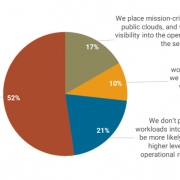Cloud price increases damage trust
In general, the prices of cloud services either remain level or decrease. There are occasional price increases, but these are typically restricted to specific features; blanket price increases across product families are rare.
Price cuts are often the result of improved operating efficiencies. Through automation, slicker processes, Moore’s law improvements in hardware and economies of scale, cloud providers can squeeze their costs and pass savings on to their customers (see Cloud generations drive down prices).
Cost base isn’t the only factor impacting price. Cloud providers need to demonstrate ongoing value. Value is the relationship between function and cost. Although central processing units are becoming increasingly powerful, most users don’t see the functionality of a slightly faster clock speed as valuable — they would rather pay less. As a result, the price of virtual machines tends to decrease.
The price of other cloud services remains flat or decreases more slowly than virtual machines. With these services, the cloud provider pockets the benefits of improved operational efficiencies or invests it in new functionality to increase the perceived value of the service. Occasionally cloud providers will cut the price of these services to garner attention and drive sales volume. Unlike virtual machines, users seek improved capability (at least for the time being) rather than lower prices.
Price increases are rare because of two reasons. First, improvements in operational efficiencies mean the provider doesn’t have to increase prices to maintain or grow margin. Second, the cloud provider doesn’t want to be perceived as taking advantage of customers that are already locked into their services.
Cloud buyers place significant trust in their cloud providers. Only a decade ago, cloud computing was viewed as being unsuitable for enterprise deployments by many buyers. Trusting a third party to host business-impacting applications takes a leap of faith: for example, there is no service level agreement that adequately covers the business cost of an outage. Cloud adoption has grown significantly over the past decade, and this reflects the increased trust in both the cloud model and individual cloud providers.
One of the major concerns of using cloud computing is vendor lock-in: users can’t easily migrate applications hosted on one cloud provider to another. (See Cloud scalability and resiliency from first principles.) If the price of the cloud services increases, the user has no choice but to accept the price increase or else plan a costly migration.
Despite this financial anxiety, price increases have not materialized. Most cloud providers have realized that increasing prices would damage the customer trust they’ve spent so long cultivating. Cloud providers want to maintain good relationships with their customers, so that they are the de facto provider of choice for new projects and developments.
However, cloud providers face new and ongoing challenges. The COVID-19 pandemic and the current Russia-Ukraine conflict have disrupted supply chains. Cloud providers may also face internal cost pressures and spend more on energy, hardware components and people. But raising prices could be perceived as price-gouging, especially as their customers are operating under similar economic pressures.
In light of these challenges, it’s surprising that Google Cloud has announced that some services will increase in price from October this year. These include a 50% increase to multiregion nearline storage and the doubling of some operations fees. Load balancers will also be subject to an outbound bandwidth charge. Google Cloud has focused on convincing users that it is a relationship-led, enterprise-focused company (not just a consumer business). To make such sweeping price increases would appear to damage its credibility in this regard.
How will these changes affect Google Cloud’s existing customers? It all depends on the customer’s application architecture. Google Cloud maintains it is raising prices to fall in line with other cloud providers. It is worth noting, however, that a price increase doesn’t necessarily mean Google Cloud will be more expensive than other cloud providers.
In Q3 2021, Google Cloud revenue increased by 45% to $4.99 billion, up from $3.44 billion in Q3 2020. Despite this growth, the division reported an operating loss of $644 million. Google Cloud’s revenue trails Amazon Web Services and Microsoft Azure by a wide margin, so Google Cloud may be implementing these price increases with a view to building a more profitable and sustainable business.
Will current and prospective customers consider the price increases reasonable or will they feel their trust in Google Cloud has been misplaced? Vendor lock-in is a business risk that needs managing — what’s not clear today is how big a risk it is.











